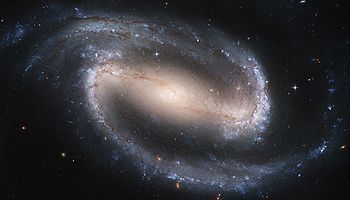- NGC 1300
-
NGC 1300 
A Hubble Space Telescope (HST) image of NGC 1300.
Credit: HST/NASA/ESA.Observation data (J2000 epoch) Constellation Eridanus Right ascension 03h 19m 41.1s[1] Declination -19° 24′ 41″[1] Redshift 0.005260 (1577 ± 4 km/s)[1] Distance 61.3 Mly (18.8 Mpc) [2] Type (R')SB(s)bc [1] Apparent dimensions (V) 6′.2 × 4′.1[1] Apparent magnitude (V) 11.4[1] Other designations MCG-03-09-018,[1] ESO 547 -G 31,[1]
PGC 12412[1]See also: Galaxy, List of galaxies NGC 1300 is a barred spiral galaxy about 61 million light-years away in the constellation Eridanus. The galaxy is about 110,000 light-years across; just slightly larger than our own galaxy, the Milky Way. It may be part of the Eridanus Cluster.[3] It was discovered by John Frederick William Herschel in 1835.[citation needed]
Contents
Image
The image on the right was taken with Hubble Space Telescope during September 2004. It is a composite using four filters: Blue (with a center wavelength of 435 nm), Visual (555 nm), Infrared (814 nm) and Hydrogen-alpha (658 nm).[4] The image's resolution, a myriad of fine details, some of which have never before been seen, is seen throughout the galaxy's arms, disk, bulge, and nucleus. Blue and red supergiant stars, star clusters, and star-forming regions are well resolved across the spiral arms, and dust lanes trace out fine structures in the disk and bar. Numerous more distant galaxies are visible in the background, and are seen even through the densest regions of NGC 1300.
In the core of the larger spiral structure of NGC 1300, the nucleus shows its own extraordinary and distinct "grand-design" spiral structure that is about 3,300 light-years long. Only galaxies with large-scale bars appear to have these grand-design inner disks — a spiral within a spiral. Models suggest that the gas in a bar can be funneled inwards, and then spiral into the center through the grand-design disk, where it can potentially fuel a central black hole. NGC 1300 is not known to have an active nucleus, however, indicating either that there is no black hole, or that it is not accreting matter.
See also
- NGC 1672 - a similar spiral galaxy
References
- ^ a b c d e f g h i "NASA/IPAC Extragalactic Database". Results for NGC 1300. http://nedwww.ipac.caltech.edu/cgi-bin/nph-objsearch?search_type=Obj_id&objid=9121&objname=15. Retrieved 2007-03-15.
- ^ Atkinson, J.W., et al. (May 2005). "Supermassive black hole mass measurements for NGC 1300 and NGC 2748 based on HST emission-line gas kinematics". Monthly Notices of the Royal Astronomical Society 359 (2): 504–520. arXiv:astro-ph/0502573. Bibcode 2005astro.ph..2573A. doi:10.1111/j.1365-2966.2005.08904.x.
- ^ "The Fornax and Eridanus Clusters". An Atlas of the Universe. http://www.atlasoftheuniverse.com/galgrps/for.html. Retrieved 2010-05-03.
- ^ "Image of the Beautiful Barred Spiral Galaxy NGC 1300". News Release: STScI-2005-01. NASA, ESO. released 10 Jan 2005. http://hubblesite.org/newscenter/archive/releases/2005/01/image/a/. Retrieved 12 Dec 2008.
External links
Categories:- Barred spiral galaxies
- Eridanus Group
- Eridanus constellation
- NGC objects
- PGC objects
Wikimedia Foundation. 2010.
